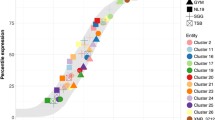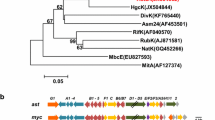Abstract
Genome sequencing has revealed that actinomycetes possess the potential to produce many more secondary metabolites than previously thought. The existing challenge is to devise efficient methods to activate these silent biosynthetic gene clusters (BGCs). In Streptomyces ansochromogenes, disruption of wblA, a pleiotropic regulatory gene, activated the expression of cryptic tylosin analogues and abolished nikkomycin production simultaneously. Overexpressing pathway-specific regulatory genes tylR1 and tylR2 can also trigger the biosynthesis of silent tylosin analogues, in which TylR1 exerted its function via enhancing tylR2 expression. Bacterial one-hybrid system experiments unveiled that WblA directly inhibits the transcription of tylR1 and tylR2 to result in the silence of tylosin analogues BGC. Furthermore, WblA can activate the nikkomycin production through up-regulating the transcription of pleiotropic regulatory gene adpA. More interestingly, AdpA can activate sanG (an activator gene in nikkomycin BGC) but repress wblA. Our studies provide a valuable insight into the complex functions of pleiotropic regulators.
Similar content being viewed by others
Data availability
Genome sequence and RNAseq data presented in this study are openly available in China National Microbiology Data Center (NMDC), and the accession number of the BioProject is [NMDC10017856]. Data of genomic DNA of S. ansochromogenes 7100 can be found under accession number NMDC60029072. RNA-seq data of S. ansochromogenes 7100 can be found under accession number NMDC40009909 (WT_24h), NMDC40009910 (WT_48h), NMDC40009911 (ΔwblA_24h), and NMDC40009912 (ΔwblA_48h).
References
Baltz, R.H. (2006). Marcel Faber Roundtable: is our antibiotic pipeline unproductive because of starvation, constipation or lack of inspiration? J Ind Microbiol Biotechnol 33, 507–513.
Baral, B., Akhgari, A., and Metsä-Ketelä, M. (2018). Activation of microbial secondary metabolic pathways: avenues and challenges. Synth Syst Biotechnol 3, 163–178.
Bu, X.L., Weng, J.Y., He, B.B., Xu, M.J., and Xu, J. (2019). A novel AdpA homologue negatively regulates morphological differentiation in Streptomyces xiamenensis 318. Appl Environ Microbiol 85, e03107–18.
Bu, X.L., Weng, J.Y., He-Lin Yu, J.Y., Xu, M.J., and Xu, J. (2020). Three transcriptional regulators positively regulate the biosynthesis of polycyclic tetramate macrolactams in Streptomyces xiamenensis 318. Appl Microbiol Biotechnol 104, 701–711.
Bush, M.J. (2018). The actinobacterial WhiB-like (Wbl) family of transcription factors. Mol Microbiol 110, 663–676.
Chawla, M., Parikh, P., Saxena, A., Munshi, M.H., Mehta, M., Mai, D., Srivastava, A.K., Narasimhulu, K.V., Redding, K.E., Vashi, N., et al. (2012). Mycobacterium tuberculosis WhiB4 regulates oxidative stress response to modulate survival and dissemination in vivo. Mol Microbiol 85, 1148–1165.
Geiman, D.E., Raghunand, T.R., Agarwal, N., and Bishai, W.R. (2006). Differential gene expression in response to exposure to antimycobacterial agents and other stress conditions among seven Mycobacterium tuberculosis whiB- like genes. Antimicrob Agents Chemother 50, 2836–2841.
Guan, H., Li, Y., Zheng, J., Liu, N., Zhang, J., and Tan, H. (2019). Important role of a LAL regulator StaR in the staurosporine biosynthesis and high-production of Streptomyces fradiae CGMCC 4.576. Sci China Life Sci 62, 1638–1654.
Guo, M., Feng, H., Zhang, J., Wang, W., Wang, Y., Li, Y., Gao, C., Chen, H., Feng, Y., and He, Z.G. (2009). Dissecting transcription regulatory pathways through a new bacterial one-hybrid reporter system. Genome Res 19, 1301–1308.
Jefferson, R.A., Kavanagh, T.A., and Bevan, M.W. (1987). GUS fusions: beta-glucuronidase as a sensitive and versatile gene fusion marker in higher plants. EMBO J 6, 3901–3907.
Kieser, T., Bibb, M. J., Chater, K. F., and Hopwood, D. A. (2000). Practical Streptomyces Genetics. John Innes Foundation, Norwich.
Kim, J.S., Lee, H.N., Lee, H.S., Kim, P., and Kim, E.S. (2013). A WblA-binding protein, SpiA, involved in Streptomyces oxidative stress response. J Microbiol Biotechnol 23, 1365–1371.
Laureti, L., Song, L., Huang, S., Corre, C., Leblond, P., Challis, G.L., and Aigle, B. (2011). Identification of a bioactive 51-membered macrolide complex by activation of a silent polyketide synthase in Streptomyces ambofaciens. Proc Natl Acad Sci USA 108, 6258–6263.
Lee, H.N., Park, S.H., Choi, S.S., and Kim, E.S. (2010). Identification and characterization of wblA ortholog, a global antibiotic down-regulator in Tautomycetin-producing Streptomyces sp. CK4412. J Biotechnol 150, 372.
Li, J., Wang, W., Liu, X., Tian, Y., Tan, H., and Zhang, J. (2022). A butenolide signaling system synergized with biosynthetic gene modules led to effective activation and enhancement of silent oviedomycin production in Streptomyces. Metab Eng 72, 289–296.
Li, P., Guo, Z., Tang, W., and Chen, Y. (2018). Activation of three natural product biosynthetic gene clusters from Streptomyces lavendulae CGMCC 4.1386 by a reporter-guided strategy. Synth Syst Biotechnol 3, 254–260.
Li, Y., Yu, H., Guan, H., Li, J., Zhang, J., Xiang, H., Li, J., and Tan, H. (2021). Activation of cryptic antibiotic biosynthetic gene clusters guided by RNA-seq data from both Streptomyces ansochromogenes and ΔwblA. Antibiotics 10, 1097.
Liao, G., Li, J., Li, L., Yang, H., Tian, Y., and Tan, H. (2010). Cloning, reassembling and integration of the entire nikkomycin biosynthetic gene cluster into Streptomyces ansochromogenes lead to an improved nikkomycin production. Microb Cell Fact 9, 6.
Liu, G., Chater, K.F., Chandra, G., Niu, G., and Tan, H. (2013). Molecular regulation of antibiotic biosynthesis in Streptomyces. Microbiol Mol Biol Rev 77, 112–143.
Liu, N., Guan, H., Niu, G., Jiang, L., Li, Y., Zhang, J., Li, J., and Tan, H. (2021a). Molecular mechanism of mureidomycin biosynthesis activated by introduction of an exogenous regulatory gene ssaA into Streptomyces roseosporus. Sci China Life Sci 64, 1949–1963.
Liu, X., Wang, W., Li, J., Li, Y., Zhang, J., and Tan, H. (2021b). A widespread response of Gram-negative bacterial acyl-homoserine lactone receptors to Gram-positive Streptomyces γ-butyrolactone signaling molecules. Sci China Life Sci 64, 1575–1589.
Liu, Y., Ren, C.Y., Wei, W.P., You, D., Yin, B.C., and Ye, B.C. (2019). A CRISPR-Cas9 strategy for activating the Saccharopolyspora erythraea erythromycin biosynthetic gene cluster with knock-in bidirectional promoters. ACS Synth Biol 8, 1134–1143.
Lu, C., Liao, G., Zhang, J., and Tan, H. (2015). Identification of novel tylosin analogues generated by a wblA disruption mutant of Streptomyces ansochromogenes. Microb Cell Fact 14, 173.
Myronovskyi, M., Welle, E., Fedorenko, V., and Luzhetskyy, A. (2011). β-Glucuronidase as a sensitive and versatile reporter in actinomycetes. Appl Environ Microbiol 77, 5370–5383.
Nah, H.J., Park, J., Choi, S., and Kim, E.S. (2021). WblA, a global regulator of antibiotic biosynthesis in Streptomyces. J Indust Microbiol Biotechnol 48, kuab007.
Nah, J.H., Park, S.H., Yoon, H.M., Choi, S.S., Lee, C.H., and Kim, E.S. (2012). Identification and characterization of wblA-dependent tmcT regulation during tautomycetin biosynthesis in Streptomyces sp. CK4412. Biotechnol Adv 30, 202–209.
Noh, J.H., Kim, S.H., Lee, H.N., Lee, S.Y., and Kim, E.S. (2010). Isolation and genetic manipulation of the antibiotic down-regulatory gene, wblA ortholog for doxorubicin-producing Streptomyces strain improvement. Appl Microbiol Biotechnol 86, 1145–1153.
Ostash, B., Doud, E., and Walker, S. (2012). ABC transporter genes from Streptomyces ghanaensis moenomycin biosynthetic gene cluster: roles in antibiotic production and export. Arch Microbiol 194, 915–922.
Park, J.C., Park, J.S., Kim, Y., Kim, P., Kim, E.S., and Lee, H.S. (2016). SpiE interacts with Corynebacterium glutamicum WhcE and is involved in heat and oxidative stress responses. Appl Microbiol Biotechnol 100, 4063–4072.
Sambrook, J., and Russell, D. (2001). Molecular cloning: A laboratory Manual, 3rd ed. Cold Spring Harbor Laboratory, Cold Spring Harbor, New York.
Sherwood, E.J., and Bibb, M.J. (2013). The antibiotic planosporicin coordinates its own production in the actinomycete Planomonospora alba. Proc Natl Acad Sci USA 110, E2500–2509.
Singh, A., Crossman, D.K., Mai, D., Guidry, L., Voskuil, M.I., Renfrow, M. B., and Steyn, A.J.C. (2009). Mycobacterium tuberculosis WhiB3 maintains redox homeostasis by regulating virulence lipid anabolism to modulate macrophage response. PLoS Pathog 5, e1000545.
Smith, L.J., Stapleton, M.R., Fullstone, G.J.M., Crack, J.C., Thomson, A.J., Le Brun, N.E., Hunt, D.M., Harvey, E., Adinolfi, S., Buxton, R.S., et al. (2010). Mycobacterium tuberculosis WhiB1 is an essential DNA-binding protein with a nitric oxide-sensitive iron-sulfur cluster. Biochem J 432, 417–427.
Wang, W., Zhang, J., Liu, X., Li, D., Li, Y., Tian, Y., and Tan, H. (2018). Identification of a butenolide signaling system that regulates nikkomycin biosynthesis in Streptomyces. J Biol Chem 293, 20029–20040.
Xu, J., Zhang, J., Zhuo, J., Li, Y., Tian, Y., and Tan, H. (2017). Activation and mechanism of a cryptic oviedomycin gene cluster via the disruption of a global regulatory gene, adpA, in Streptomyces ansochromogenes. J Biol Chem 292, 19708–19720.
Yu, P., Liu, S.P., Bu, Q.T., Zhou, Z.X., Zhu, Z.H., Huang, F.L., and Li, Y.Q. (2014). WblAch, a pivotal activator of natamycin biosynthesis and morphological differentiation in Streptomyces chattanoogensis L10, is positively regulated by AdpAch. Appl Environ Microbiol 80, 6879–6887.
Acknowledgements
This work was supported by the National Key Research and Development Program of China (2020YFA0907800), the National Natural Science Foundation of China (32170043, 82173720) and the Beijing Natural Science Foundation (7212153). We thank Dr. Cheng Lu for his assistance in EMSA experiments of AdpA to its targets P wblA, construction of ΔwblA-pks1 and partial HPLC analysis. We would like to thank Professor Zhengguo He (College of Life Science and Technology, Guangxi University, Nanning, China) for kindly providing bacterial one-hybrid reporter system pRomoter, pTRGMCM and reporter strain E. coli XL1-Blue MRF’ Kan strain.
Author information
Authors and Affiliations
Corresponding authors
Additional information
Compliance and ethics
The author(s) declare that they have no conflict of interest.
Supporting Information
11427_2022_2199_MOESM1_ESM.docx
An intricate regulation of WblA controlling production of silent tylosin analogues and abolishment of expressible nikkomycin, approximately 832 KB.
Rights and permissions
About this article
Cite this article
Li, Y., Guan, H., Li, J. et al. An intricate regulation of WblA controlling production of silent tylosin analogues and abolishment of expressible nikkomycin. Sci. China Life Sci. 66, 612–625 (2023). https://doi.org/10.1007/s11427-022-2199-1
Received:
Accepted:
Published:
Issue Date:
DOI: https://doi.org/10.1007/s11427-022-2199-1




